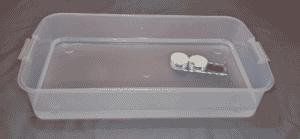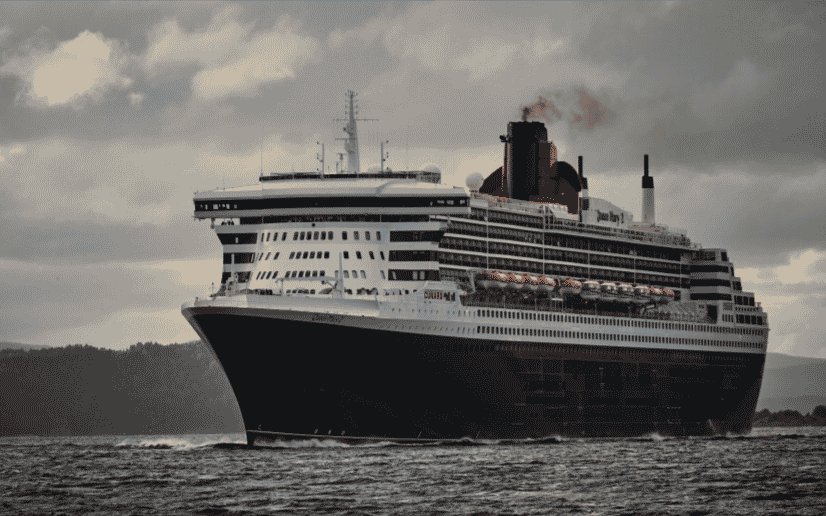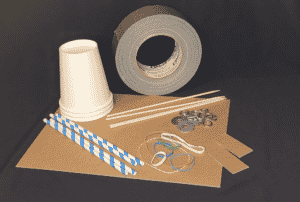Overview
Materials
Per Person or Per Team:
|
For Testing:
|
Instructions
Canoes, sailboats, yachts, and even ocean liners share three characteristics:
- They float (they are buoyant).
- They stay upright (they’re stabilized to keep from tipping over).
- They move via some source of energy, such as wind (captured by sails), fuel (to run a motor), or human (paddling with oars or paddles).
In this activity, students will design a boat that floats, doesn’t tip over, and moves with energy generated by a rubber band!
INSTRUCTIONS
DEFINE THE PROBLEM
- Share the challenge with students: Design and build a boat powered by a rubber band.
- Give students the specs:
- Use only the materials provided (but you don’t have to use them all).
- The rubber band is the boat’s only power source (no blowing or pushing the boat).
- The boat has to go 3 feet without sinking. (Or choose a different length depending upon the size of the container and/or your students’ grade level.)
- Show students the materials. Get students thinking with some preliminary questions:
- How can you create a boat with the materials we have? The cup(s) will act as the boat’s shell, known as the hull. Other materials will be used to build and secure a rubber band motor.
- What keeps boats from tipping over? Introduce the term “ballast,” or weight placed in the bottom of a boat, to stabilize it. Design matters too; the wider the hull, the less likely it is to tip over.
- Where should the paddle or propeller go? In order to move forward, you need to push backward.
 Show students how a rubber band and piece of chipboard can be turned into a paddle. Have each student practice looping a rubber band around their thumb and index finger. Put a piece of chipboard inside the loop and twist the rubber band around it until it is very tightly wound. Let go and watch the chipboard spin. If students are working in pairs, see what happens if the rubber band is looped around one finger of each student and pulled taut from the added length. Does the chipboard paddle for longer or faster?
Show students how a rubber band and piece of chipboard can be turned into a paddle. Have each student practice looping a rubber band around their thumb and index finger. Put a piece of chipboard inside the loop and twist the rubber band around it until it is very tightly wound. Let go and watch the chipboard spin. If students are working in pairs, see what happens if the rubber band is looped around one finger of each student and pulled taut from the added length. Does the chipboard paddle for longer or faster?- Distribute the materials. Give students time to explore the properties of the materials and experiment as they plan their design, especially rubber bands of varying length and thickness. Ask them to think about how they’ll attach their rubber-band-powered paddle or propeller to their boat. Encourage them to test ideas in the water before they finalize their design.
- Tell students to build their boats. Assure them that after they test their first designs, they can change and improve their boats. Hint: Water may splash over the sides of the boat or make materials soggy. How can they use the tape to waterproof their designs (e.g., covering the chipboard in tape)?
- During testing, measure how far each boat travels and encourage students to watch each trial closely. They can pick up ideas for improving their own boats.
 Once everyone has had a chance to test their design, hold a discussion. What were the characteristics of the boats that went the farthest? What about the ones that didn’t go very far—what was different about them?
Once everyone has had a chance to test their design, hold a discussion. What were the characteristics of the boats that went the farthest? What about the ones that didn’t go very far—what was different about them?- Tell students to gather another set of materials and try again. For teams whose boats propelled all the way across the tub, up the ante: Tell them to experiment with their designs and race each other. They can also see if their boat can hold a ping-pong ball or a few pipe cleaner people and still propel to the other side.
BRAINSTORM SOLUTIONS
BUILD AND TEST
EVALUATE AND REDESIGN
Guiding questions
- Which boat shape is easiest to propel?
- What happens if you change the location or amount of ballast?
- What is the weak point in the frame for your paddle or propeller, and how can you change the design to make it sturdier?
- What happens if you wind the rubber band too tight?
Engineering & science connections
ELASTIC POTENTIAL ENERGY
A rubber band can make a paddle or propeller spin if it’s twisted tightly enough. When something elastic is twisted, stretched, compressed, or bent—in any way forced into a different shape—it stores energy. The stretched bow of an archer and the spring in a windup clock or toy are other examples of elastic potential energy. When the force is removed, the potential energy turns into kinetic energy as the object springs back to its original shape.
- After the rubber band is wound tight but before it is let go, it is storing energy. Stored energy is called potential energy. Once the rubber band starts twirling, it’s in motion. The energy of motion is called kinetic energy. As the paper cup boat paddles through the water, the spinning paddle, the moving boat, and the little waves it creates each have kinetic energy.
- Engineers are figuring out new ways to change potential energy into kinetic energy. The fuel in a car goes from chemical potential energy to kinetic energy once the engine is running, but gasoline isn’t the only way to make this happen; engineers are working on creating synthetic, nonpolluting fuels. Electricity and biofuels are other energy sources engineers have used to generate the kinetic energy a car needs in order to move.
- Why do you fall through the air but not through water? When you’re floating in water, the water exerts an upward buoyant force that cancels out the downward force of gravity. The buoyant force on an object is equal to the weight of fluid displaced by that object. So anything that is less dense than water—lighter than the same volume of water—will float, while anything denser than water will sink. Humans are less dense than water, so we float. But a ball of solid gold is 19 times as dense as water, so it would fall very quickly through water.
- Many large boats are made of dense metal, so why don’t ocean liners and cruise ships sink? While these ships are heavy, they are also huge—so they displace an enormous amount of water. Because they are mostly hollow, they are lighter than the water they displace, and the buoyant force of displaced ocean water can cancel out their weight. Today engineers are designing even bigger, lighter ships that take advantage of buoyancy to use less fuel.



0 Comments